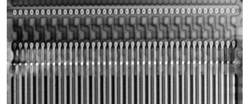5 things to know: IBM’s racetrack memory chip
Breakthrough in memory technology brings industry closer to replacing hard-disk drives
At this week’s IEEE International Electron Devices meeting, IBM demonstrated a breakthrough in “racetrack” memory technology, a nonvolatile method of storing data as magnetic patterns on tiny wires.

IBM’s prototype racetrack memory chip features a collection of nanowires that play a key role to fitting more data into smaller spaces. (Credit: theverge.com)
The breakthrough here is the fact that IBM was able to successfully demonstrate racetrack memory using CMOS technology (a much more widespread and thus, more affordable, method of production.) It’s a big step for the company’s research team, as the world is quickly gravitating toward faster, cheaper, and more durable ways of storing data. (Just look at how fast cloud computing is catching on!)
If you’re only slightly familiar with racetrack memory, here are five things to know about the new IBM prototype:
1. Specs
IBM’s prototype racetrack memory chip is integrated with CMOS technology on 200-mm-diameter silicon wafers.[1] It features an array of 256 in-plane, magnetized, horizontal nanowires to it, each approximately 10 micrometers long, 150 nanometers wide, and 20 nanometers thick. [2]
2. Nanowires
The nanowires were created by depositing a nickel-iron coating on top of silicon. The team then etched it into separate wires using standard chip-baking photolithography. Nickel-iron was used because it is considered a soft magnetic material and can be easily magnetized by an external field.
A problem with this, however, is that nickel-iron is also easily demagnetized. As a result, this particular chip can only move one bit of data at a time. IBM has acknowledged this issue and stated that it is also experimenting with hard magnetic materials, which get their magnetic properties from their tightly fixed crystalline structure and makes them not as easy to demagnetize. It also means that they can hold on to domains more tightly which, in turn, make it easier to move multiple bits of data at a time.
3. Technology
At the end of each nanowire is a transistor that delivers pulses of electrons with carefully controlled quantum-mechanical “spin” to it to write data into the nanowire as magnetic stripes. The “spin” orientates the electrons in one of two ways to represent the 0’s and 1’s of computer data.
To read data, the stripes are moved along the nanowire (again, one at a time) and read by an analog to a hard drive’s read head, which detects the boundaries of the magnetic stripes (as opposed to its polarity).
4. Speed
IBM says that the technology could potentially read and write data hundreds of thousands of times faster than what’s possible on today’s flash disks or hard-disk drives. This would put it in the same arena as DRAM (dynamic random access memory) chips, though, one of the downfalls of DRAM is the fact that the chip “forgets” data as soon as the computers power is turned off. There is tremendous potential for racetrack memory to be successful in this regard.
Putting it all into perspective, current racetrack memories take approximately 20 to 32 nanoseconds to read or write a bit, as compared to 3 million nanoseconds for a conventional hard-disk drive.[3]
5. Durability
The circuitry involved with racetrack memory can be wiped and rewritten millions of times, or at least that’s IBM’s goal. This is a stark contrast to flash memory drives that typically become unreliable after any single bit has gone through 100,000+ writes.
IBM has acknowledged that more work needs to be done in this area, but the potential is there for the company to vastly improve “cell operation repeatability.”
Conclusion
This is a big announcement and a positive step forward for IBM to (finally) commercialize the long-researched, much-hyped technology. It comes at a good time, too, as all indications point to the fact that consumers are eager for a new data storage solution. It should be interesting to see how quickly IBM can build upon this breakthrough. ■
References
[1] www-03.ibm.com/press/us/en/pressrelease/36135.wss
[2] technologyreview.com/computing/39239
[3] theverge.com/2011/12/5/2612480/ibm-racetrack-memory-demonstration-iedm
Advertisement
Learn more about Electronic Products Magazine





